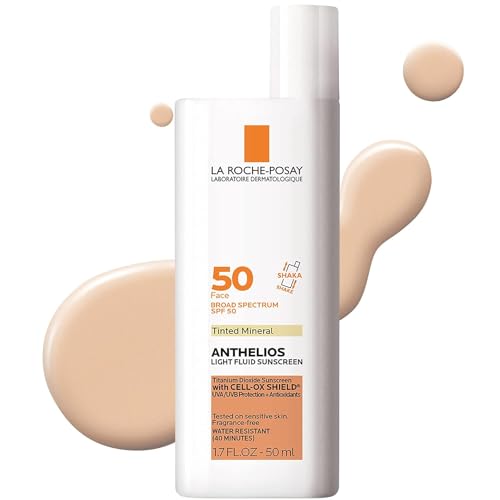Sunlight, while essential for life, holds a hidden danger: ultraviolet (UV) radiation. This invisible force can silently damage your skin, increasing your risk of skin cancer, the most common cancer in the United States. But the good news is, you have a powerful weapon in your arsenal – sunscreen.
Sunscreen is not just a summer accessory; it’s a critical health tool, proven to significantly reduce your risk of developing skin cancer, including the deadly melanoma. This article equips you with the knowledge and tools to become a sun protection expert, empowered to shield yourself and your loved ones from the harmful effects of UV rays.
More from Glowing Gorgeous: Find out here the Best Silicone-Free Moisturizers And Why Do You Care
Dive in and discover:
- How sun exposure fuels skin cancer and why sunscreen is your first line of defense.
- The science behind sunscreen: understanding different types, ingredients, and SPF ratings.
- Choosing the right sunscreen for your skin type and activities.
- Mastering the art of application: techniques for maximum protection.
- Beyond sunscreen: sun-smart strategies for complete skin cancer prevention.
- Addressing common myths and concerns about sunscreen and sun protection.
By incorporating these essential practices into your life, you can enjoy the sun safely and confidently, minimizing your skin cancer risk for a healthier, brighter future.
- Unmasking the Enemy: Understanding Sun Exposure and Skin Cancer
- How Sunscreen Protects You
- Research and Evidence:
- Sunscreen & Photoaging Prevention
- Choosing the Right Sunscreen for Skin Cancer Prevention
- Sunscreen Labels:
- Practices to Prevent Skin Cancer:
- Dispelling Myths and Concerns about Sunscreen:
- Frequently Asked Questions about Sunscreen and Skin Cancer:
Unmasking the Enemy: Understanding Sun Exposure and Skin Cancer
The sun’s radiant warmth and golden glow can be deceiving. Hidden within its spectrum lies UV radiation, categorized as UVA and UVB rays, both with damaging effects on your skin.
UV Radiation & Skin Damage
UVA rays penetrate deep into the skin, reaching the collagen and elastin fibers, contributing to wrinkles, sunspots, and premature aging. UVB rays are responsible for sunburns and play a critical role in the development of skin cancer.
Over time, repeated exposure to UV radiation disrupts your skin cells, potentially leading to uncontrolled growth and the formation of cancerous tumors. Skin cancer manifests in various forms, with melanoma being the most aggressive and potentially fatal.
But here’s the hopeful truth: you don’t have to surrender to the sun’s power. Sunscreen provides a potent shield, absorbing or reflecting UV rays before they can harm your skin. In the next section, we’ll delve into the fascinating world of sunscreen, exploring its types, ingredients, and the magic of SPF.
Skin Cancer Types & Their Risks
Before we dive into the tactical arsenal of sunscreen choices, it’s crucial to understand the enemy we’re facing: skin cancer. This umbrella term encompasses a diverse range of malignancies, each posing unique threats and risks. Knowing your foe strengthens your resolve to defend yourself.
- Melanoma: The most aggressive and potentially fatal form, melanoma arises from pigment-producing cells (melanocytes). It can rapidly spread to other organs if left undetected. Early diagnosis and timely treatment are crucial for successful outcomes.
- Non-Melanoma Skin Cancers: While less aggressive than melanoma, non-melanoma skin cancers like basal cell carcinoma (BCC) and squamous cell carcinoma (SCC) still pose significant risks. BCC is the most common form, characterized by uncontrolled growth in the basal layer of the skin. SCC tends to develop on sun-exposed areas and can invade deeper tissues if left untreated.
Skin cancer’s diverse forms share a common culprit: UV radiation. Overexposure to UVA and UVB rays disrupts DNA in skin cells, leading to uncontrolled growth and potentially cancerous mutations. This highlights the critical role of sunscreen in deflecting this invisible threat, acting as a life-saving shield against the development of both melanoma and non-melanoma skin cancers.
Now, equipped with this understanding of the diverse landscape of skin cancer and the threat posed by UV radiation, we can confidently move forward to explore your best defense weapon: choosing the right sunscreen.
More from Glowing Gorgeous: Find out here Hyram’s Recommended Face Sunscreens For The Summer
How Sunscreen Protects You
With a dizzying array of sunscreens lining pharmacy shelves, choosing the right one can feel like navigating a minefield. But fear not! Equipped with the right knowledge, you can transform this task into a strategic mission, selecting the perfect sunscreen for your unique needs.
Broad-Spectrum Protection
Think of sunscreen as a fortress guarding your skin. While we often hear about UVB rays causing sunburns, the insidious threat lies in both UVA and UVB radiation. Here’s why broad-spectrum protection is your non-negotiable ally:
- UVB Rays: The “burners,” responsible for sunburns and contributing to skin cancer development.
- UVA Rays: The “silent invaders,” penetrating deeper into the skin, causing premature aging, wrinkles, and potentially contributing to skin cancer.
A regular sunscreen might block UVB rays, but leaving the door open for UVA is like having a guard at the front gate while thieves sneak in through the back. Broad-spectrum sunscreens act as vigilant sentinels, shielding you from both UVA and UVB threats, minimizing your risk of sunburns, premature aging, and long-term skin cancer development.
Think of it as an investment in your future self, preventing wrinkles and age spots while safeguarding your health from skin cancer. Choose broad-spectrum protection – it’s your ultimate defense against the full spectrum of sun’s harmful rays.
SPF Explained – Decoding the Numbers
SPF, or Sun Protection Factor, is often thrown around, but what does it really mean? It’s not a shield against all sun exposure, but rather a measure of how effectively your sunscreen blocks UVB rays. Here’s the breakdown:
| SPF | UVB Ray Blocking% | Sunburn Protection | Ideal Activities |
|---|---|---|---|
| 15 | 93% | Moderate | Everyday use, light outdoor activities |
| 30 | 97% | Strong | Extended sun exposure, outdoor activities |
| 50 | 98% | Very Strong | Intense sun exposure, water sports |
Remember, SPF isn’t a guarantee of invincibility. Reapply every two hours, especially after swimming or sweating, and don’t forget sun-protective clothing and seeking shade for optimal protection.
Think of SPF as a multiplier: Higher SPF doesn’t necessarily mean you can stay in the sun indefinitely. It simply buys you more time before UVB rays start impacting your skin. Choose wisely based on your activity level and sun exposure.
Chemical vs. Physical Barrier:
Sunscreens come in two main categories: chemical and physical. Chemical sunscreens absorb UV rays and convert them into heat, which is then released from the skin. Physical sunscreens, like those containing zinc oxide and titanium dioxide, act as a mineral shield, reflecting UV rays away from your skin. Both types can be effective, so choose the one that feels most comfortable and suits your skin type. For sensitive skin, physical sunscreens often work better.
Research and Evidence:
Now that we understand the tools at our disposal, let’s look at the science backing their effectiveness.
Studies Proving Sunscreen’s Effectiveness
The evidence is clear: sunscreen is a life-saving tool. Here are some compelling findings:
- Regular sunscreen use can reduce the risk of melanoma by up to 50%. (Source: The Skin Cancer Foundation)
- Daily application of SPF 15 or higher can decrease the risk of squamous cell carcinoma (SCC) by 40%. (Source: National Cancer Institute)
- Studies show that consistent sunscreen use throughout life significantly reduces the overall risk of developing skin cancer. (Source: British Journal of Dermatology)
These findings paint a clear picture: sunscreen isn’t just a feel-good practice; it’s a powerful preventative measure backed by solid science.
Sunscreen & Photoaging Prevention
Beyond its cancer-fighting powers, sunscreen is your secret weapon against the visible signs of aging. Sun exposure is a major culprit behind wrinkles, sunspots, and loss of skin elasticity. Here’s how sunscreen comes to the rescue:
- Blocks UVA rays, the primary contributor to premature aging.
- Protects collagen and elastin, the fibers responsible for youthful skin.
- Helps prevent pigmentation and sunspots formation.
Regular sunscreen use, combined with other sun-protective measures, can delay the appearance of wrinkles and maintain a youthful glow for years to come. Think of it as an investment in your future – one that pays off in both health and appearance.
Choosing the Right Sunscreen for Skin Cancer Prevention
Just like you wouldn’t use the same weapon for every battle, choosing the right sunscreen requires understanding your unique needs and vulnerabilities. Consider this section your personalized armor selection chamber, equipped with the knowledge to find your perfect sun defense ally.
Skin Type and Sunscreen Selection:
Oily skin deserves a lightweight, non-comedogenic formula like gels or oil-free lotions, avoiding heavy creams that can clog pores. Sensitive skin benefits from mineral-based sunscreens with zinc oxide or titanium dioxide, as chemical ingredients can cause irritation. Dry skin thrives with hydrating lotions or creams rich in moisturizing ingredients like hyaluronic acid. Remember, patch-testing any new sunscreen before full application is crucial for identifying potential sensitivities.
Active Ingredients & Their Benefits:
Sunscreens come armed with different active ingredients, each offering specific advantages. Zinc oxide and titanium dioxide are physical blockers, reflecting UV rays away from your skin. Chemical sunscreens like avobenzone, oxybenzone, and octisalate absorb UV rays and convert them into heat, which is released from the skin. Choose zinc oxide or titanium dioxide for sensitive skin and reef-safe options, while chemical sunscreens may offer a lighter, non-greasy feel.
Formulations and Preferences:
Sunscreen comes in a buffet of textures and formats to suit your lifestyle. Lotions are versatile and ideal for everyday use, while sprays are convenient for quick application, though they may need frequent reapplication. Gels are lightweight and perfect for oily skin, while sticks are handy for sensitive areas like lips and noses. Consider your personal preference and activity level when choosing a form you’ll consistently wear.
Water Resistance for Activities:
Swimming, sweating, and playing outdoors demand a water-resistant sunscreen. Look for labels featuring “40 minutes water resistance” or “80 minutes water resistance” to determine how long your sunscreen will hold up before reapplication. Remember, even water-resistant formulas need refreshing after activities or long sun exposure.
Sunscreen Labels:
Reading sunscreen labels isn’t deciphering ancient texts, but it does require your detective skills. Here are the key clues to uncover:
Key Information to Look For:
- SPF: Opt for broad-spectrum SPF 30 or higher for everyday use and SPF 50+ for extended sun exposure or outdoor activities.
- Active Ingredients: Identify the ingredients to ensure they suit your skin type and preferences.
- Broad-Spectrum: This crucial keyword indicates protection against both UVA and UVB rays.
- Water Resistance: Choose the appropriate level based on your planned activities.
- Expiration Date: Expired sunscreens lose their effectiveness, so check and replace regularly.
Understanding Expiration Dates and Proper Storage:
Just like food, sunscreens have expiration dates. Check the bottom of the bottle and replace your sunscreen annually or after the expiry date passes. Store your sunscreen in a cool, dry place, away from direct sunlight and heat, to maintain its effectiveness.
Practices to Prevent Skin Cancer:
Think of sunscreen application like building a fortress against UV rays. Every meticulous brushstroke adds a layer of defense, maximizing your protection and minimizing the risk of skin cancer.
H3: Generous Application Techniques:
Imagine your skin as a blank canvas. Don’t be stingy with the sunscreen! Aim for a visible, even layer, using about a shot glass worth of sunscreen for your entire body. Remember these key areas:
- Face and neck: Apply sunscreen liberally, including ears, lips, and the delicate area under your chin.
- Don’t forget the tops of your feet and hands!
- Part your hair and apply to your scalp, especially if it’s thinning.
- Behind the knees, the backs of your arms, and the tops of your shoulders are often neglected spots.
Remember, sunscreen application is a daily ritual, not a one-time event.
Reapplication Frequency and Importance:
Sunscreen, like your phone battery, needs a recharge to maintain its effectiveness. Reapply every two hours, especially after swimming, sweating, or towel drying. Remember, even water-resistant formulas need a refresh to keep your shield strong. Set reminders on your phone or wear a waterproof watch with a sun protection alert to ensure consistent reapplication.
Other Strategies to Prevent Skin Cancer:
Sunscreen is a powerful ally, but it’s not a lone soldier in the fight against skin cancer. Consider these additional strategies for comprehensive protection:
Think of clothing as your first line of defense. Choose garments with a UPF (Ultraviolet Protection Factor) of 50 or higher, like long-sleeved shirts, wide-brimmed hats, and sunglasses. Breathable fabrics like linen and cotton are ideal for keeping cool.
Timing is everything. Plan outdoor activities for early mornings or late afternoons when the sun’s rays are less intense. Seek shade whenever possible, especially during peak sun hours between 10 am and 4 pm.
Early Detection: Skin Self-Checks and Regular Screenings:
Regular self-checks are crucial for early skin cancer detection. Familiarize yourself with the ABCDEs of melanoma (Asymmetry, Border irregularity, Color variation, Diameter greater than 6mm, Evolving) and monitor any suspicious changes in your moles or skin lesions. Schedule regular skin cancer screenings with your dermatologist for professional evaluation.
Remember, skin cancer prevention is a multi-pronged approach. By combining these strategies with a diligent sunscreen routine, you can enjoy the outdoors safely and confidently, minimizing your risk of skin cancer and ensuring a healthy, sun-kissed future.
Dispelling Myths and Concerns about Sunscreen:
Sunscreen, despite its undeniable benefits, often faces a barrage of questions and concerns. Let’s clear the air and ensure you have the knowledge to make informed choices about your sun protection:
Vitamin D Deficiency and Sunscreen:
Myth: Sunscreen blocks vitamin D absorption, leading to deficiencies.
Fact: While sunscreen does filter some UVB rays, which are necessary for vitamin D synthesis, it doesn’t significantly impact your vitamin D levels. Most people get enough vitamin D through incidental sun exposure during daily activities, even with sunscreen use. However, if you’re concerned, consult your doctor for a vitamin D test and potential supplementation.
Allergic Reactions and Sensitivity:
Myth: All sunscreens cause allergic reactions and irritate sensitive skin.
Fact: While some individuals experience mild irritation or allergic reactions to certain sunscreen ingredients, especially chemical ones, alternatives exist. Mineral-based sunscreens with zinc oxide and titanium dioxide are generally well-tolerated by sensitive skin. Patch-testing any new sunscreen before full application is crucial to identify potential sensitivities. Additionally, consult your dermatologist for recommendations if you have concerns.
Safety of Chemical Sunscreens:
Myth: Chemical sunscreens contain harmful chemicals that can be absorbed into the bloodstream and cause health issues.
Fact: While some concerns exist about the safety of certain chemical sunscreen ingredients, the FDA has deemed them safe and effective for topical use. The amount absorbed through skin is minimal, and no conclusive evidence links sunscreens to long-term health problems. However, if you prefer, opt for mineral-based sunscreens for additional peace of mind.
Frequently Asked Questions about Sunscreen and Skin Cancer:
“I tan easily, do I still need sunscreen?”
Yes, absolutely! Even if you tan easily, your skin is still vulnerable to UV damage and the risk of skin cancer. Tanning is a sign of skin damage, not protection. Sunscreen helps prevent sunburn, premature aging, and skin cancer regardless of your skin tone.
“Sunscreen clogs pores and causes breakouts.”
Not all sunscreens are created equal. Choose oil-free, non-comedogenic formulas specifically designed for acne-prone skin. These formulas won’t clog pores and are less likely to trigger breakouts.
“Natural alternatives are just as effective.”
While some natural ingredients like vitamin E and antioxidants offer limited sun protection benefits, they don’t provide the broad spectrum, long-lasting protection of sunscreen. Relying solely on natural alternatives can leave you vulnerable to significant UV damage and increase your risk of skin cancer.
The sun might warm us and nourish our planet, but its invisible rays hold a hidden threat. Skin cancer, the most common form of cancer, casts a long shadow, but you hold the power to step into the sunlight with confidence.
The power to choose a healthier future lies in your hands. Ditch the tanning myth, embrace the shade, and invest in consistent sun protection. By prioritizing your skin’s well-being, you can write a narrative of sun-kissed adventures, free from the fear of skin cancer. Let your glow be a testament to informed choices and empowered self-care.



 La Roche-Posay Anthelios Melt-In Milk Body & Face Sunscreen SPF 60, Oil Free...
La Roche-Posay Anthelios Melt-In Milk Body & Face Sunscreen SPF 60, Oil Free... La Roche-Posay Anthelios Tinted Sunscreen SPF 50, Ultra-Light Fluid Broad...
La Roche-Posay Anthelios Tinted Sunscreen SPF 50, Ultra-Light Fluid Broad... innisfree Daily UV Defense Sunscreen Broad Spectrum SPF 36 Face Lotion, 1.69 Fl...
innisfree Daily UV Defense Sunscreen Broad Spectrum SPF 36 Face Lotion, 1.69 Fl...
Comments